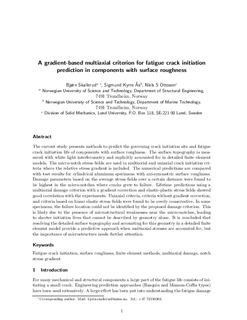| dc.contributor.author | Skallerud, Bjørn Helge | |
| dc.contributor.author | Ås, Sigmund Kyrre | |
| dc.contributor.author | Ottosen, Niels S. | |
| dc.date.accessioned | 2019-02-11T13:41:26Z | |
| dc.date.available | 2019-02-11T13:41:26Z | |
| dc.date.created | 2018-08-24T10:30:09Z | |
| dc.date.issued | 2018 | |
| dc.identifier.citation | International Journal of Fatigue. 2018, 117 384-395. | nb_NO |
| dc.identifier.issn | 0142-1123 | |
| dc.identifier.uri | http://hdl.handle.net/11250/2584825 | |
| dc.description.abstract | The current study presents methods to predict the governing crack initiation site and fatigue crack initiation life of components with surface roughness. The surface topography is measured with white light interferometry and explicitly accounted for in detailed finite element models. The micro-notch stress fields are used in multiaxial and uniaxial crack initiation criteria where the relative stress gradient is included. The numerical predictions are compared with test results for cylindrical aluminum specimens with axi-symmetric surface roughness. Damage parameters based on the average stress fields over a certain distance were found to be highest in the micro-notches where cracks grew to failure. Lifetime predictions using a multiaxial damage criterion with a gradient correction and elastic-plastic stress fields showed good correlation with the experiments. Uniaxial criteria, criteria without gradient correction, and criteria based on linear elastic stress fields were found to be overly conservative. In some specimens, the failure location could not be identified by the proposed damage criterion. This is likely due to the presence of microstructural weaknesses near the micro-notches, leading to shorter initiation lives that cannot be described by geometry alone. It is concluded that resolving the detailed surface topography and accounting for this geometry in a detailed finite element model provide a predictive approach when multiaxial stresses are accounted for, but the importance of microstructure needs further attention. | nb_NO |
| dc.language.iso | eng | nb_NO |
| dc.publisher | Elsevier | nb_NO |
| dc.title | A gradient-based multiaxial criterion for fatigue crack initiation prediction in components with surface roughness | nb_NO |
| dc.title.alternative | A gradient-based multiaxial criterion for fatigue crack initiation prediction in components with surface roughness | nb_NO |
| dc.type | Journal article | nb_NO |
| dc.description.version | submittedVersion | nb_NO |
| dc.source.pagenumber | 384-395 | nb_NO |
| dc.source.volume | 117 | nb_NO |
| dc.source.journal | International Journal of Fatigue | nb_NO |
| dc.identifier.doi | 10.1016/j.ijfatigue.2018.08.020 | |
| dc.identifier.cristin | 1604237 | |
| dc.description.localcode | This is a submitted manuscript of an article published by Elsevier Ltd in International Journal of Fatigue, 20 August 2018. | nb_NO |
| cristin.unitcode | 194,64,45,0 | |
| cristin.unitcode | 194,64,20,0 | |
| cristin.unitname | Institutt for konstruksjonsteknikk | |
| cristin.unitname | Institutt for marin teknikk | |
| cristin.ispublished | true | |
| cristin.fulltext | preprint | |
| cristin.qualitycode | 2 | |
